
The Ultimate Guide to Dallas-Ft Worth Landscaping Makeovers
Published: 26/07/2024 | Updated: 31/07/2024
Right at the heart of the bustling North Texas, Dallas-Fort Worth balances modern urban life with the rich heritage of the state. While one of the fastest growing cities in the country, it still boasts gripping beauty. Its natural environment inspires every homeowner to upgrade their landscape design. With every natural attraction, Dallas opens a world of possibilities for homeowners. However, just like any other city, it has its own distinct climate and diverse topography.


So, to improve your garden’s aesthetic and ecological value, you need to grow some native plants. In this article, we’ve green lighted top DFW plants to grow if you want to build a serene haven amidst a fast-paced city.
The Best Plants to Grow in Dallas Fort Worth: Your Ticket to an Impressive Garden Transformation
Thanks to the area’s temperate winters and hot summers, gardeners and homeowners can grow a vast collection of plants. What is the trick to creating a visually stunning yet perfectly functioning space? Opt for plants that look pretty and fit in well with the surrounding ecosystem. Here, native plants are the way to go. Requiring minimal care, they adapt well to the local environment. And they need less water, all while offering vital habitat for nearby wildlife.
Whether you want to design a lush haven or a drought-tolerant yard, there’s a wide variety of plants to meet your vision. From the full-of-character look of the Hibiscus to the dainty blooms of the petunia, you are about to access an extensive collection of stunning DFW plants. Step up your style game with the following varieties:
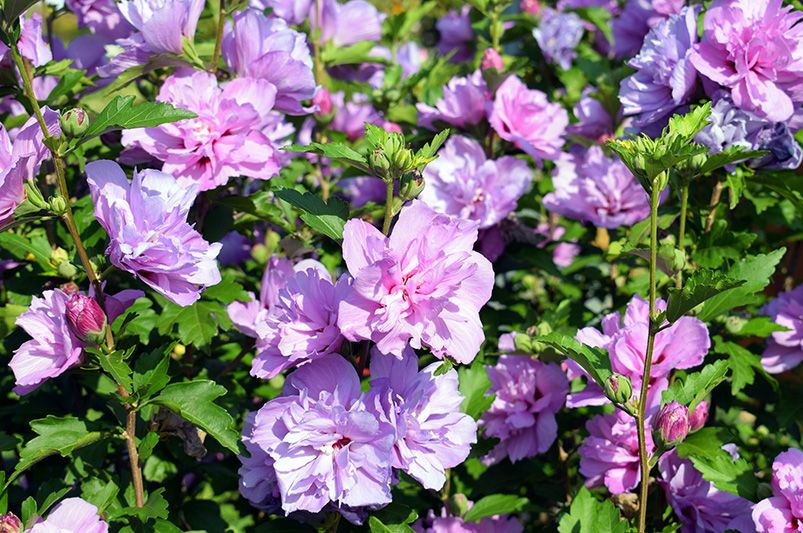
Ardens Rose of Sharon
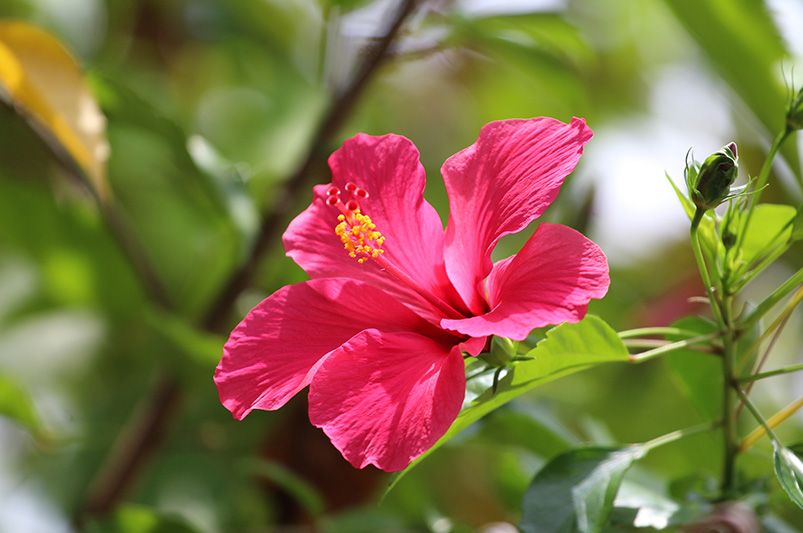
Mars Madness Hardy Hibiscus
Mars Madness Hardy Hibiscus is a type of hibiscus known for its striking and vibrant flowers. Here’s a bit more about it:
-
Appearance: The Mars Madness Hardy Hibiscus typically features large, showy blooms that are often deep red or burgundy in color. These flowers can be quite dramatic, sometimes measuring up to 8-10 inches in diameter.
-
Hardiness: As indicated by its name, this hibiscus variety is hardy, meaning it can tolerate colder temperatures than many other hibiscus species. It’s usually suitable for growing in USDA Hardiness Zones 4 to 9, making it a versatile choice for various climates.
-
Growth Habit: It generally grows as a perennial shrub or herbaceous plant, reaching heights of around 3-5 feet. It tends to have a bushy growth habit with large, broad leaves.
-
Care Requirements: The Mars Madness Hardy Hibiscus prefers full sun to partial shade and requires well-drained soil. It’s relatively low-maintenance but benefits from regular watering, especially during dry spells. In colder climates, it might need some winter protection, such as mulch.
-
Uses: This plant is often used in garden beds, borders, or as a focal point in landscape designs due to its dramatic flowers. It can also attract pollinators like butterflies and hummingbirds.
Overall, it's a great choice if you want a striking, hardy plant that can add a splash of color to your garden.
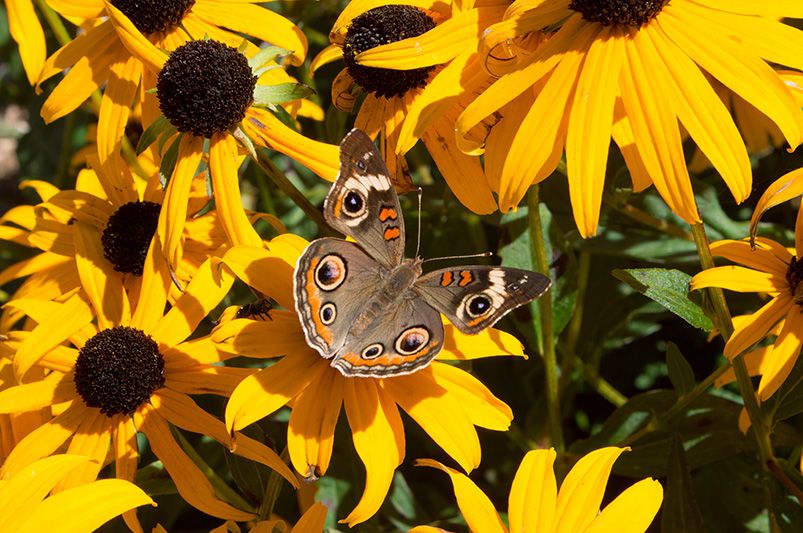
Glitters Like Gold Black Eyed Susan
Glitters Like Gold Black-eyed Susan (Rudbeckia hirta 'Glitters Like Gold') is a cultivar of the popular Black-eyed Susan plant, known for its vibrant and distinctive flowers. Here’s a detailed overview:
- Appearance: This cultivar is celebrated for its striking, golden-yellow blooms with dark centers. The petals are slightly ruffled, giving the flowers a unique and textured look. The bright, golden color of the flowers can add a lively pop to garden beds and borders.
- Growth Habit: The Glitters Like Gold Black-eyed Susan typically grows as a compact, bushy perennial. It generally reaches a height of around 12-18 inches, with a similar spread. The foliage is usually dark green, providing a nice contrast to the bright flowers.
- Hardiness: It is hardy in USDA Hardiness Zones 4 to 9, which means it can tolerate a range of climates and is suitable for various regions.
- Care Requirements: This plant thrives in full sun to partial shade and prefers well-drained soil. It is relatively low-maintenance but benefits from regular watering, particularly during dry periods. Deadheading spent flowers can encourage continued blooming and improve the plant’s appearance.
- Blooming Period: The Glitters Like Gold Black-eyed Susan typically blooms from mid-summer to early fall, providing color when many other plants start to fade.
- Uses: It is a versatile plant that works well in garden beds, borders, and container gardens. Its vibrant flowers attract pollinators like butterflies and bees, making it a good choice for a pollinator-friendly garden.
- Pest and Disease Resistance: This cultivar is generally resistant to most pests and diseases. However, it may occasionally experience issues with aphids or powdery mildew. Proper spacing and good air circulation can help mitigate these problems.
The Glitters Like Gold Black-eyed Susan is an excellent choice if you’re looking for a plant that adds cheerful, golden blooms to your garden with relatively easy care requirements.
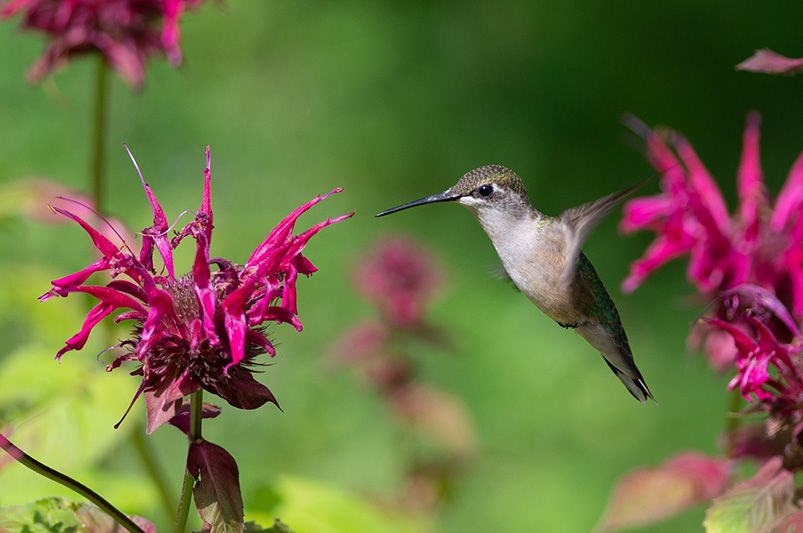
Rockin' Raspberry Bee Balm
Rockin' Raspberry Bee Balm (Monarda 'Rockin' Raspberry') is a cultivar of bee balm, known for its eye-catching flowers and vibrant color. Here’s what you should know about this plant:
- Appearance: The Rockin' Raspberry Bee Balm is notable for its striking raspberry-pink blooms. The flowers are tubular and arranged in dense, rounded clusters, giving the plant a full and colorful appearance. The foliage is typically a rich green, which contrasts nicely with the bright flowers.
- Growth Habit: This cultivar is a perennial that generally grows to about 18-24 inches in height and width. It has a bushy, upright growth habit and can form clumps over time. The plant features aromatic, lance-shaped leaves that add to its visual and sensory appeal.
- Hardiness: The Rockin' Raspberry Bee Balm is hardy in USDA Hardiness Zones 4 to 9, making it suitable for a wide range of climates, from cooler regions to more temperate areas.
- Care Requirements: Bee balm prefers full sun to partial shade and thrives in well-drained, moist soil. Regular watering is important, especially during dry spells. It can benefit from occasional deadheading to extend the blooming period and maintain its appearance. It can be prone to powdery mildew, so good air circulation and proper spacing can help prevent this issue.
- Blooming Period: This plant blooms from mid-summer to early fall, adding vibrant color to the garden during the growing season.
- Uses: The Rockin' Raspberry Bee Balm is an excellent addition to garden beds, borders, and pollinator gardens. Its bright flowers attract pollinators such as bees, butterflies, and hummingbirds, making it a valuable plant for supporting local wildlife.
- Pest and Disease Resistance: While generally resistant to most pests, bee balm can sometimes be affected by powdery mildew, particularly in humid conditions. Selecting disease-resistant varieties and ensuring good airflow around the plant can help manage this issue.
Overall, the Rockin' Raspberry Bee Balm is a vibrant and attractive choice for adding color to your garden while supporting pollinators.
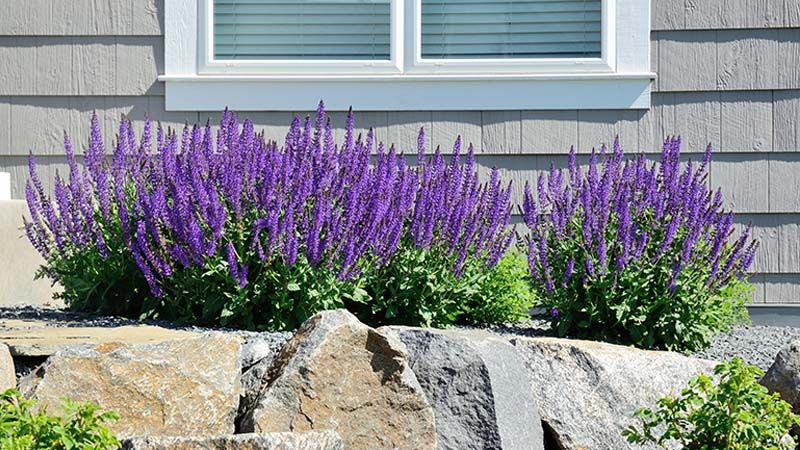
Caradonna Salvia
Caradonna Salvia (Salvia nemorosa 'Caradonna') is a popular cultivar of the perennial salvia plant, known for its striking visual appeal and garden versatility. Here’s a detailed overview:
- Appearance: Caradonna Salvia is celebrated for its tall, spiky flower spikes that are a deep, rich purple. The flowers appear in dense, vertical clusters, making a bold statement in garden beds and borders. The plant also features aromatic, lance-shaped green leaves that provide a nice contrast to the vibrant blooms.
- Growth Habit: This salvia typically grows to about 18-24 inches in height with a similar spread. It has a compact, bushy growth habit and tends to form clumps. Its upright, columnar flower spikes add vertical interest to the garden.
- Hardiness: Caradonna Salvia is hardy in USDA Hardiness Zones 4 to 8, allowing it to thrive in various climates, from cooler to moderately temperate regions.
- Care Requirements: This plant prefers full sun but can tolerate partial shade. It thrives in well-drained soil and is relatively drought-tolerant once established. Regular watering during dry periods can help maintain its vigor. Deadheading spent blooms can encourage continued flowering and improve the plant’s overall appearance.
- Blooming Period: Caradonna Salvia usually blooms from late spring to early summer and can sometimes produce additional blooms later in the season. The long-lasting flowers provide extended color in the garden.
- Uses: This salvia is versatile in the landscape, making it a great choice for garden beds and borders and a component in mixed perennial gardens. Its tall flower spikes can add height and structure to flower beds, and its vibrant blooms attract pollinators such as bees and butterflies.
- Pest and Disease Resistance: Caradonna Salvia is generally resistant to pests and diseases. However, good garden practices, such as proper spacing and good air circulation, can help prevent issues like powdery mildew or fungal diseases.
Caradonna Salvia is valued for its stunning purple flowers, reliability, and ease of care. It is a favorite among gardeners looking to add vibrant color and attract pollinators.
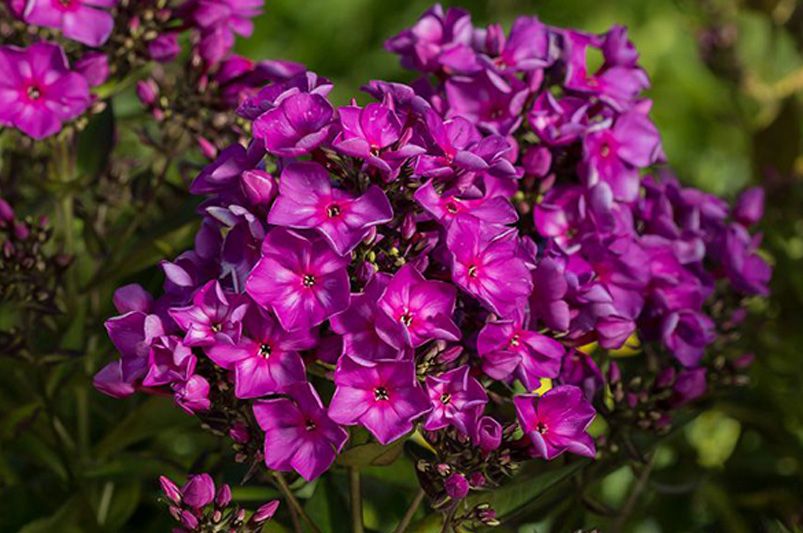
Candy Store Grape Lollipop Phlox
Candy Store Grape Lollipop Phlox (Phlox paniculata 'Candy Store Grape Lollipop') is a garden phlox cultivar known for its vivid and eye-catching blooms. Here’s a comprehensive overview of this plant:
- Appearance: The Candy Store Grape Lollipop Phlox features striking, deep purple to magenta flowers with a lollipop-like appearance. The blooms are often arranged in dense, rounded clusters on sturdy stems, creating a dramatic floral display. The foliage is typically green, providing a nice backdrop for the vibrant flowers.
- Growth Habit: This phlox variety generally grows to a height of about 18-24 inches and has a similar spread. It forms clumps with a bushy, upright growth habit. The plant is known for its sturdy stems, which help support the heavy flower clusters and reduce the risk of flopping.
- Hardiness: Candy Store Grape Lollipop Phlox is hardy in USDA Hardiness Zones 4 to 8, suitable for cooler to temperate climates.
- Care Requirements: This plant thrives in full sun to partial shade and prefers well-drained soil that remains consistently moist. Regular watering, especially during dry periods, is important to ensure healthy growth and abundant blooms. Deadheading spent flowers can help extend the blooming period and keep the plant looking its best.
- Blooming Period: The Candy Store Grape Lollipop Phlox blooms from mid-summer to early fall. Its vibrant flowers can give your garden a splash of color during the growing season.
- Uses: This phlox is ideal for garden beds, borders, and mixed perennial gardens. Its bold, colorful flowers add vertical interest and attract pollinators such as butterflies and hummingbirds. It can also be used as a cut flower for arrangements.
- Pest and Disease Resistance: Phlox can be susceptible to powdery mildew, particularly in humid conditions. Choosing disease-resistant varieties and providing adequate spacing for good air circulation can help minimize this issue. Regular inspection and proper garden hygiene also contribute to preventing and managing diseases.
Candy Store Grape Lollipop Phlox is valued for its vibrant and unique flower color, ease of care, and ability to attract pollinators, making it a popular choice for adding dramatic color to gardens and landscapes.
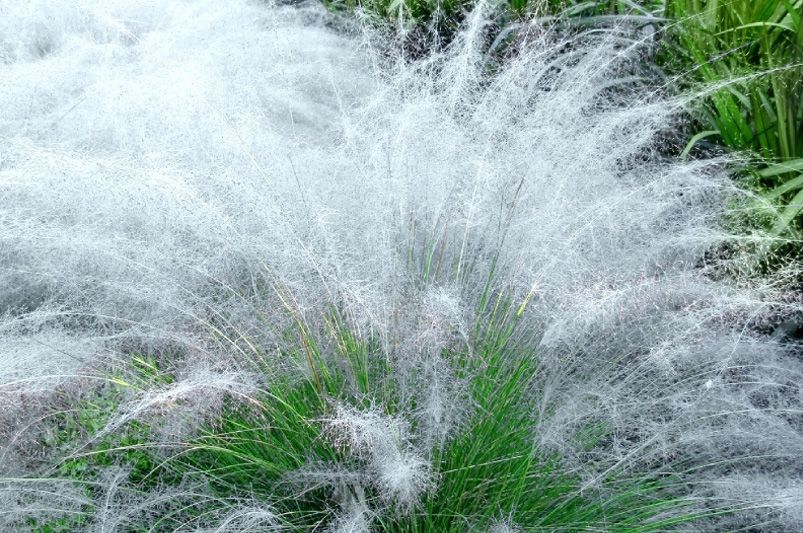
White Muhly Grass
White Muhly Grass (Muhlenbergia capillaris 'White') is a cultivar of the native Muhly Grass known for its distinctive and attractive appearance. Here's a detailed look at this plant:
- Appearance: White Muhly Grass is celebrated for its airy, cloud-like flower heads that are white or pale. These flower heads are composed of fine, delicate, thread-like flowers that give a soft, ethereal appearance. The plant’s foliage is typically green and grass-like, with a fine texture that complements the airy blooms.
- Growth Habit: This grass generally forms a clump that reaches a height of about 2-3 feet and has a similar spread. The plant has an upright, arching growth habit and is known for its graceful, wispy appearance.
- Hardiness: White Muhly Grass is hardy in USDA Hardiness Zones 6 to 10, making it suitable for various climates, from temperate to warmer regions. It’s relatively tolerant of multiple soil types and conditions.
- Care Requirements: This plant prefers full sun to partial shade and thrives in well-drained soil. Once established, it is relatively drought-tolerant, making it a low-maintenance choice for many gardens. Minimal pruning is required, but removing spent flower heads can help maintain the plant’s appearance and promote new growth.
- Blooming Period: White Muhly Grass blooms from late summer to early fall. The flower heads provide a light, airy contrast to the garden and add interest throughout the season.
- Uses: This ornamental grass is often used in garden beds and borders and as a component in prairie or meadow-style gardens. Its soft, ethereal blooms add a unique texture and visual interest to the landscape. It can also be used in mass plantings for a striking effect.
- Pest and Disease Resistance: White Muhly Grass is generally resistant to pests and diseases. However, ensuring good air circulation and avoiding overly wet conditions can help prevent potential issues such as fungal diseases.
White Muhly Grass is valued for its distinctive, airy flower heads and ability to add a soft, ethereal quality to garden landscapes. Its low maintenance and adaptability make it popular for formal and informal garden designs.

Red Yucca
Red Yucca (Hesperaloe parviflora) is a striking and hardy succulent plant known for its vibrant flower spikes and ornamental foliage. Here’s a detailed overview of this plant:
- Appearance: Red Yucca is renowned for its tall, dramatic flower spikes that can reach 3-5 feet. The flowers are tubular and typically red or coral-colored, although some varieties may have orange or yellow flowers. The plant's foliage consists of narrow, arching, bluish-green leaves that form a rosette at the base. The leaves are often edged with tiny, fine teeth, giving them a slightly rugged appearance.
- Growth Habit: The plant forms a clump of long, slender, arching leaves that can grow to about 1-2 feet in height and spread. The flower spikes rise above the foliage, creating a striking vertical element in the garden.
- Hardiness: Red Yucca is hardy in USDA Hardiness Zones 5 to 11, making it suitable for various climates, from cooler regions to more temperate and warmer areas. It is especially well-suited to hot, dry conditions.
- Care Requirements: This plant thrives in full sun and well-drained soil. Once established, it is highly drought-tolerant, making it an excellent choice for xeriscaping or low-water gardens. Minimal watering is needed, and the plant can often survive on natural rainfall in its preferred climate. It’s also tolerant of poor soil conditions but benefits from good drainage.
- Blooming Period: Red Yucca typically blooms from late spring to summer, with the flower spikes lasting several months. The vibrant flowers attract hummingbirds and butterflies, adding color and wildlife interest to the garden.
- Uses: This plant is often used in xeriscaping, rock gardens, desert landscapes, and as an accent plant in garden beds and borders. Its bold flower spikes and architectural foliage make it a focal point in any garden design.
- Pest and Disease Resistance: Red Yucca is generally resistant to pests and diseases. However, it can occasionally be affected by aphids or mealybugs. Ensuring good air circulation and avoiding overly wet conditions can help prevent potential issues.
Overall, Red Yucca is valued for its striking flower spikes, architectural foliage, and adaptability to dry conditions, making it a popular choice for adding dramatic color and texture to various garden settings.
Build Your Dallas-Fort Worth Dream Home With ShrubHub
In summary, the secret to successful gardening in the Dallas-Fort Worth area is selecting the right plants. Picks that can withstand heat and dryness, such as Red Yucca and White Muhly Grass, are ideal for the region’s particular climate and soil. Whether you’re looking for vibrant blooms, enticing foliage, or a variety to draw in birds and butterflies, there are a lot of plants that make your garden look amazing and remain healthy.
At ShrubHub, our designers breathe life into outdoor spaces that align with the region’s climate and aesthetic. They combine creativity with practical knowledge, ensuring your outdoor space is both a secluded sanctuary and a complement to the Dallas-Fort Worth backdrop.
It’s about time to transform your outdoor space into a personal retreat. Sign up now for free and get a 70% discount on your landscape design!


